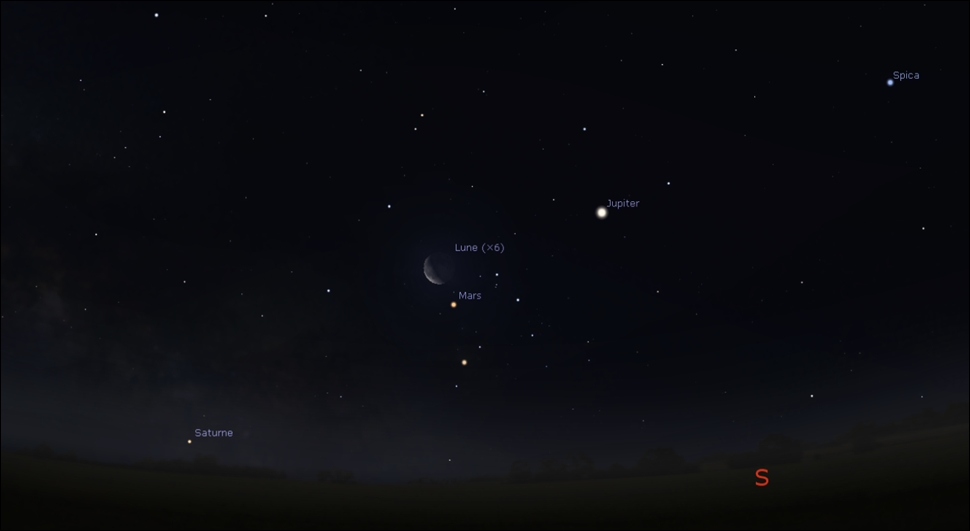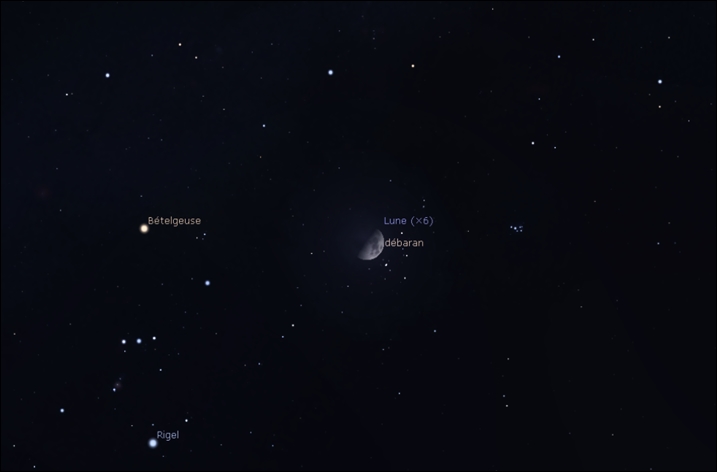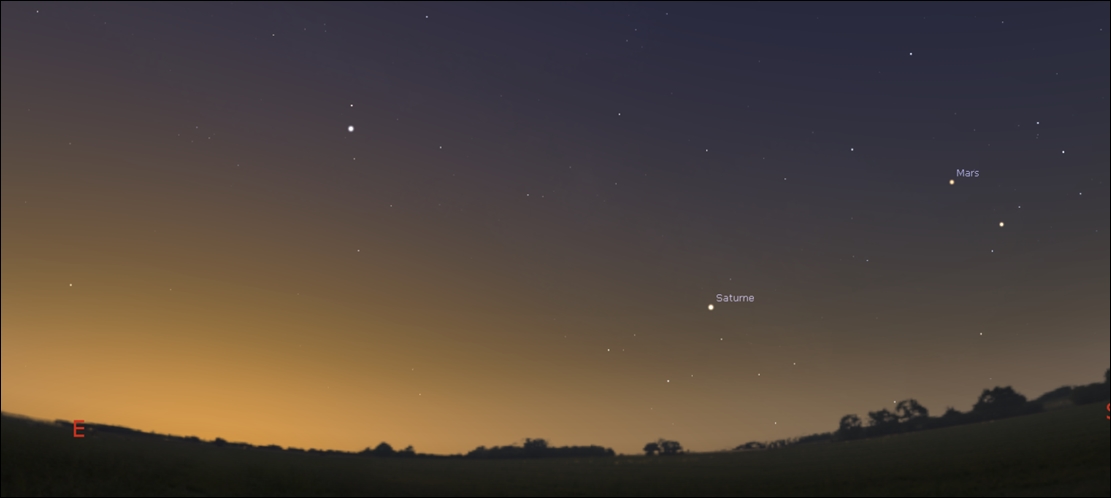
still need the January edition?
![]() .Events .Moon .Planets .Major Events .Minor Planets, NEOs .Comets .Shooting Stars .Occultations .Sun .check more! (occultations observers are advised to check in 'Events', and to turn to such dedicated sites like the I.O.T.A).. don't forget to check the weather! For the US: the NOAA . color codes: Wwd worldwide, UsA USA-Americas, EuA Europe-Africa, AsP Asia-Pacific, Chk Check for Your Zone. check the site's concept and the instructions of use
.Events .Moon .Planets .Major Events .Minor Planets, NEOs .Comets .Shooting Stars .Occultations .Sun .check more! (occultations observers are advised to check in 'Events', and to turn to such dedicated sites like the I.O.T.A).. don't forget to check the weather! For the US: the NOAA . color codes: Wwd worldwide, UsA USA-Americas, EuA Europe-Africa, AsP Asia-Pacific, Chk Check for Your Zone. check the site's concept and the instructions of use
![]()
 Editor's Choice Fine Picture
Editor's Choice Fine Picture ![]() Editor's Choice Sky At
Editor's Choice Sky At ![]()
![]()
![]() Tech News
Tech News ![]() color codes: Wwd worldwide, UsA USA-Americas, EuA Europe-Africa, AsP Asia-Pacific, Chk Check for Your Zone. check the site's concept and the instructions of use
color codes: Wwd worldwide, UsA USA-Americas, EuA Europe-Africa, AsP Asia-Pacific, Chk Check for Your Zone. check the site's concept and the instructions of use
| Tweet |
.Events Seen All Month Long .Ephemerides Proper
(data from the former yearly ephemerides generator at Fred Espenak's NASA's eclipse website; miscellaneous data with the 'Astronomical Phenomena for The Year 2018,' a joint work by the United Kingdom Hydrographic Office and the U.S. Naval Observatory; to be found at the latter's site; all time UT except otherwise stated)
Wwd Mars, Feb. 6-17, is moving about Antares, the bright star to constellation Scorpius, the Scorpion by dawn. A fine show as Ancients had named Antares -- which means 'the rival to Mars' -- because of its reddish hue! A closest is reached by about Feb. 11. Both objects are at about the 1st magnitude. Visual and photographic opportunities! Moon will come adding
Wwd Fine constellations are seen South, at the Tropics by dawn. Fine views!
1 (1) Wwd Moon past full, at all latitudes, is seen close to Regulus tonight, the bright star to constellation Leo, the Lion. There is a occultation of Regulus for some areas
1 (2) Wwd There is a occultation of Regulus, the bright star to constellation Leo, the Lion today by Moon! check more at Occultations; check more too at such sites like "The International Occultation Timing Association" (I.O.T.A.)
 | Moon close to Regulus! picture site 'Amateur Astronomy' based upon Celestia |
8 Wwd Tomorrow morning by dawn, at all latitudes, last quartered Moon is seen close to Mars. Fine!
 | Moon close to Mars! picture site 'Amateur Astronomy' based upon Celestia |
9 Wwd There is a occultation of minor planet Vesta today by Moon! check more at Occultations; check more too at such sites like "The International Occultation Timing Association" (I.O.T.A.)
10 UsA EuA Tomorrow morning by dawn, by all latitudes, last crescent is seen close to Saturn. Visual and photographic opportunities!
 | Moon close to Saturn! picture site 'Amateur Astronomy' based upon Celestia |
11 (1) AsP Tomorrow morning by dawn, by all latitudes, last crescent is seen close to Saturn. Visual and photographic opportunities!
11 (2) Wwd Moon is at its apogee at 14:16 UT (distances non available) as it also reaches a southernmost declination at 23:21 UT
14 Wwd Moon is at a descending node at 21:11 UT
15 Wwd The first solar eclipse in 2018 -- and that year's second major astronomical event -- is a partial solar eclipse, the partial solar eclipse of February 15th, 2018. check more
23 (1) Wwd First Quarter is close to Aldebaran tonight, at all latitudes, the bright star to constellation Taurus, the Bull. There is a occultation of Aldebaran for some areas
 | Moon close to Aldebaran! picture site 'Amateur Astronomy' based upon Celestia |
23 (2) Wwd There is a occultation of Aldebaran, the bright star to constellation Taurus, the Bull today by Moon! check more at Occultations; check more too at such sites like "The International Occultation Timing Association" (I.O.T.A.)
25 Wwd Moon reaches a northernmost declination at 20:07 UT
27 Wwd Moon is at its perigee at 14:48 UT (distances non available)
28 (1) UsA EuA Waxing gibbous Moon is again seen close to Regulus tonight, by all latitudes, the bright star to constellation Leo, the Lion
28 (2) Wwd Moon is at a ascending node at 05:03 UT
Occultations observers are advised to turn to such dedicated sites like the I.O.T.A as they may also check below at our Occultation section
Last Quarter is on February 7th, at 15:54 UT
New Moon is on February 13th, at 16:17 UT
First Quarter is on February 23rd, at 08:09 UT
(source: Ephemeris generator at Fred Espenak's NASA's eclipse website)
Mercury is reaching a superior conjunction on February 17th, at 12:08. Mercury is unavailable worldwide
Venus is said reappearing like a evening star beginning by the third week of February but that will need a really plain western horizon, with Venus solely about some 3 degree above! A rare occurrence however!
 | Venus barely above the horizon, a rare occurrence! picture site 'Amateur Astronomy' based upon Stellarium |
Mars Mars Observation Campaign! is reaching the point, at 6 second of apparent diameter on February 12th, when the 2018-2019 Mars Observation Campaign is beginning. Mars is a high morning star worldwide. A Mars Observation Campaign is unfolding 2018-2019 as it constitutes a remarkable, perihelic opposition, with Mars nearest to Earth at the same time it is nearest to the Sun on its orbit! Mars will reach a 24.2" of apparent diameter at its best as the observation campaign will span from when the Red Planet is reaching, then leaving 6" of apparent diameter! Don't miss those occasions of observing Mars! check more at our Mars Observation Campaign 2018-2019 page
 | Mars reaching to 6 seconds of apparent diameter, which starts the 2018-2019 Mars Observation Campaign! picture site 'Amateur Astronomy' based upon Celestia |
Jupiter now is rising by 1:16 a.m. local time in the northern hemisphere, 12:16 a.m. at the Tropics and 12:41 a.m. in the southern hemisphere
Saturn, after a conjunction last month, is already back like a fine morning star worldwide. A ring maximum aperture had been reached in 2017
 | Saturn already back like a fine morning star! picture site 'Amateur Astronomy' based upon Stellarium |
Uranus is now setting by 10:30 p.m. local time in the northern hemisphere and about the same in the southern one. A early twilight North and at the Tropics allows for observation as that mostly is untrue in the southern hemisphere
Neptune, one month ahead a conjunction, is not observable anywhere worldwide
Pluto is too low in the northern hemisphere, in the morning twilight to be observable. It is somewhat already seen at night at the Tropics and barely the same in the southern hemisphere. Pluto in 2018 is reaching a rare 'special' opposition as the latter will occur because the planet will reach its orbit's line of node. (according to the International Astronomical Union (IAU) since 2006, Pluto is not considered a planet anymore, but categorized like a dwarf planet instead along with Ceres, Eris, Makemake, and Haumea, and the prototype of a new category of 'trans-Neptunian', 'Pluto-class' objects)
The Partial Solar Eclipse of February 15th, 2018
That first solar eclipse in 2018 -- and that year's second major astronomical event -- is a partial solar eclipse, the partial solar eclipse of February 15th, 2018. That partial eclipse will be moving from eastern, to western Antarctive, starting South of Australia and ending in southern south America. check our page dedicated to that event
| CAUTION! OBSERVING A SUN ECLIPSE IS DANGEROUS AND MAY CAUSE IRREVERSIBLE EYE DAMAGE, UP TO BLINDNESS, ANNULAR AND PARTIAL ECLIPSES INCLUDED! Observing a Sun eclipse necessitates DEDICATED SAFE TECHNIQUES! |
Minor planets are those biggest asteroids in the Asteroid Belt which may be easily observed by amateurs from the Earth, namely Ceres, Pallas, Juno, and Vesta (due to the new categorization by the International Astronomical Union (IAU) by 2006, Ceres belongs to the 5 dwarf planets in the solar system with Pluto, Eris, Makemake, and Haumea). check data and charts at our section Minor Planets on the yearly Calendar page as our tutorial 'Asteroids and Asteroid Hunting' is of help too. Any remarkable event linked to a minor planet may have a notice here below
Some small asteroids dubbed Near-Earth Objects (NEOs) are regularly making close approaches at Earth. People interested in such close approaches may obtain recent and upcoming data at NASA site Near-Earth Object Program (their section "Close Approaches"). Date, miss distance in AU or Lunar Distance (LD), estimated diameter, and relative velocity are available. For further observational purposes, check at the Near-Earth Object Program ephemeris Generator. For more about NEOs see tutorial "
Once every time, the solar system treats us with a remarkable comet, a eery view spanning up to thirty degrees of sky! Most of the time however comets are the domain of dedicated observers as mostly weak and, at the most, hovering at the limit of the naked-eye visibility. A good site to get information about current such comets is the British Astronomical Association Comet Section page or also the Weekly Information about Bright Comets page (which often points to comets close to the visual magnitude). Our 'Comets and Comet Hunting' tutorial will also be helpful. Remarkable comets otherwise usually will be presented below!
->of note: dates of swarms and peaks as given below are the average ones. More refined dates may be given in the Ephemerids section
->note: shooting stars afficionados will be aware of checking Moon at the dates of the showers
for more about the meteor showers of this month, for possible other meteor showers for this month, and for more about shooting stars, generally, see our tutorial "Shooting Stars"
Each month, Moon occults some relatively bright stars, that is the Moon, beginning either with its bright or its dark visible face, is passing in front of a star. This is called an occultation. The Pleiades, on the other hand, due to their position near the eclipic, are often occulted by Moon too. Some planets, at last, along the year, may be occulted by Moon or they themselves, or their satellites, may be seen too occulting a star. The asteroids too may occult stars. Yearly lists of such phenomenons are to be found at Sky & Telescope/SkyTonight.com, either in their newsstand issues or at their site, as a list of occultations of most brilliant stars, the planets and the Pleiades are available at the I.O.T.A site (I.O.T.A. stands for "The International Occultation Timing Association"). Most notable occultations are signaled below
Regulus back, the bright star to constellation Leo, the Lion is occulted by Moon on Feb. 1st, 2018 by 19:00 UT! The show is available for Scandanavia, northern Greenland, Svalbard, northern and eastern Russia, N.E. China, N.W. Alaska, most of Japan. check more at such sites like "The International Occultation Timing Association" (I.O.T.A.)
Minor planet Vesta back is occulted by Moon on Feb. 9th, 2018 by 13:00 UT! The show is available for Chatham Island, most of Antarctica. check more at such sites like "The International Occultation Timing Association" (I.O.T.A.)
Aldebaran back, the bright star to constellation Taurus, the Bull is occulted by Moon on Feb. 23rd, 2018 by 18:00 UT! The show is available for Bermuda, N.E. North America, Greenland, most of Europe, Svalbard, most of Russia, Kazakhstan, western Mongolia, N.W. China. check more at such sites like "The International Occultation Timing Association" (I.O.T.A.)
check on this site for more about occultations, theoretically
| CAUTION! OBSERVING THE SUN IS DANGEROUS AND REQUIRES DEDICATED SAFE TECHNIQUES! |